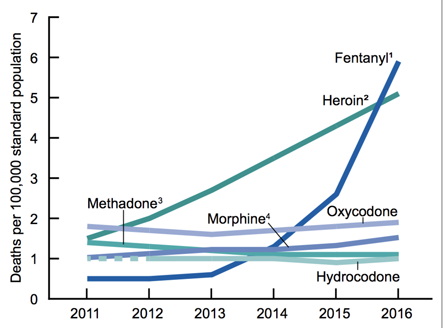These Ten Drugs Are Responsible for the Most Overdoses

When someone who is struggling with a drug habit turns on their local news and hears a report about a “New, lethal strain of heroin” or a “New batch of fentanyl that’s killing dozens of addicts,” their first thought isn’t to mourn such a sad situation or to avoid those drugs. No, their first thought is, “How do I get my hands on some of that?”
This always surprises people, but that’s just the truth. Addicts don’t avoid the most lethal of drugs. Rather, they flock to them. Every time a particularly deadly strain of narcotics hits the streets, users rally to it, trying to get their hands on the substance. Why? Because an especially deadly drug also means that it is an especially potent drug, something that will produce a powerful euphoric high, even if it costs the user his life.
This is a major contributor to so many overdoses in the last several years, and why the overdose rate for each year is significantly higher than the year before. The drugs are getting stronger, and addicts are scrambling to get a taste.
The CDC Sheds Light on Annual Overdose Rates

One of the top news headliners for 2016 was that fentanyl, a man-made pain reliever drug, surpassed heroin as the top drug involved in fatal overdoses. The issue with people dying from legal pharmaceutical pain reliever drugs has only gotten worse since then.
Fentanyl is far more potent than heroin is, hence why so many who have taken it have died from it. Whether they started taking the drug for legitimate reasons or not, the drug can end up being habit-forming and lethal.
According to the Centers for Disease Control and Prevention, 41,340 people died from drug overdoses in 2011. Compare that to 63,632 overdose deaths in 2016, a fifty percent increase from 2011. Preliminary findings from the CDC indicate that a little more than 72,000 people died in 2017, with drug overdose deaths now being one of the leading causes of falling life expectancy in recent years. (See report, pg. 4, Table A.)
The Top Drugs for Overdose Deaths
While all drugs have negative health implications and should be avoided, not all drugs pose the same level of fatal overdose risk.
Opioids, in particular, tend to be the most lethal. While a cocaine user or a meth user is still likely to die from a drug-related cause (such as a car accident while driving drugged), drug-related crime, or some other accident caused while high, an opioid user is at risk for losing his or her life merely from the act of using the opioid itself.

Opioids are easily the number-one drug for overdose deaths in the U.S., and they have been for years.
But not all overdose deaths are caused by opioids. Here are the different types of drugs which have caused the most damage and loss of life. This information is culled from a U.S. News exposé on the overdose crisis and the top drugs which contributed most to it:
- Diazepam. Diazepam is a benzodiazepine drug which was involved in about three percent of overdose deaths in 2016. Diazepam appears under common brand names we all recognize—like Valium.
- Hydrocodone. Once one of the most commonly prescribed opioid painkiller drugs, Hydrocodone was responsible for five percent of all overdose deaths in 2016. We see hydrocodone under common brand names like Vicodin, Norco, and Lorcet.
- Methadone. Though it is supposed to help addicts get off of drugs, methadone often just ends up getting addicts hooked on it. They substitute one drug for another and go from being heroin addicts or pill addicts to methadone addicts. Methadone was involved in about five and a half percent of overdose deaths in 2016.
- Morphine. Morphine, one of the oldest painkiller drugs still in use today, was responsible for just under eight percent of overdose deaths in the U.S. in 2016.
- Oxycodone. Invented in 1996 and introduced to the American people as one of the first, major “solutions” for pain, oxycodone was thought to be the most commonly prescribed painkiller for years. The drug was responsible for just under ten percent of all overdose deaths in 2016. This drug appears under brand names like OxyContin, Roxicodone, and Oxaydo.
- Alprazolam. More well known as Xanax, Alprazolam is the anti-anxiety drug with a lethal bite to it. It was involved in almost ten percent of all overdose deaths in 2016. Xanax is highly addictive and fully capable of causing an overdose if one takes too much of it.
- Methamphetamine. Deaths from Methamphetamine use are increasing. In fact, the drug increased in overdose deaths by more than three-hundred percent from 2011 to 2016. It was involved in just under eleven percent of all overdose deaths in 2016.
- Cocaine. Cocaine, one of the oldest drugs still in use today, is not often thought to be a drug that causes overdoses. But it is present in drug-related deaths, such as car crashes, drug crime, accidents, and injuries, etc. Cocaine was found in about seventeen percent of drug-related fatalities in 2016.
- Heroin. Heroin was involved in twenty-five percent of all overdose deaths in 2016. Heroin has made a comeback since 2011 when the drug was involved in only one and a half deaths per one-hundred-thousand population. Now it is involved in more than five deaths for every one-hundred-thousand population.
- Fentanyl. Taking 18,335 lives in 2016 and likely far more in 2017 when the numbers come in, fentanyl is currently the most lethal drug in the U.S. Fentanyl was responsible for just under twenty-nine percent of overdose deaths in 2016.
Clearly, while we need to address all manifestations of drug addiction in our nation, opioids are the drugs which cause the most deaths.
Preserving Life by Helping People Overcome Addiction

It couldn’t be more apparent that drug addiction is now a very lethal problem to have. It seems that not only are people using drugs more often, but the drugs that they are using are becoming more potent and dangerous.
This means we have to double our efforts, work even harder to prevent our loved ones from falling prey to a substance abuse crisis. And if we do have someone who succumbs to addiction, our focus then has to be helping them get off of drugs through the help of rehabilitation and treatment.
Addiction is a dark, potentially lethal path for anyone to walk, and it is up to us to try and help such individuals get off of that path.
Sources:
- https://www.cdc.gov/nchs/data/nvsr/nvsr67/nvsr67_09-508.pdf (See pg. 4, Table A.)
- https://www.usnews.com/news/health-news/slideshows/deadly-drugs-in-america-fentanyl-heroin-meth
Reviewed and Edited by Claire Pinelli ICAADC, CCS, LADC, RAS, MCAP


